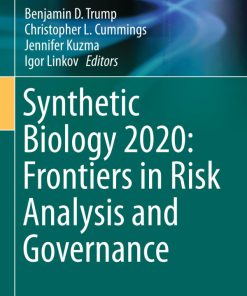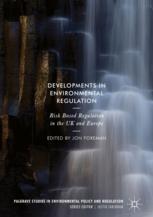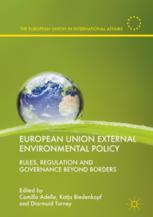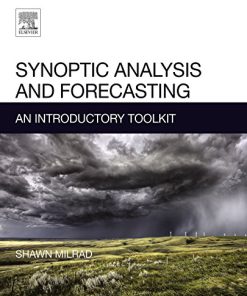Risk Analysis and Governance in EU Policy Making and Regulation An Introductory Guide 1st Edition by Bernardo Delogu 3319308227 9783319308227
$50.00 Original price was: $50.00.$25.00Current price is: $25.00.
Risk Analysis and Governance in EU Policy Making and Regulation An Introductory Guide 1st Edition by Bernardo Delogu – Ebook PDF Instant Download/DeliveryISBN: 3319308227, 9783319308227
Full download Risk Analysis and Governance in EU Policy Making and Regulation An Introductory Guide 1st Edition after payment.
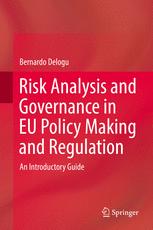
Product details:
ISBN-10 : 3319308227
ISBN-13 : 9783319308227
Author: Bernardo Delogu
This book provides an easy, but comprehensive and rigorous access to the main concepts, terminology, methods and procedures of risk analysis intended for all those involved in the EU policy and regulatory decision making on risks. It establishes a common ground of knowledge which enables a more informed dialogue on risks, a closer collaboration between decision makers and scientists and a better appraisal of the potential and limits of risk science. The book also brings together in an accessible way much multidisciplinary knowledge which had been dispersed over many technical documents and specialist books. The EU is in the front line of health, safety and environmental risk management. GMOs, food safety, hazardous chemicals, climate change, radiation hazards, are just a few of the popular risk issues addressed by the EU through policy and regulatory measures. The risk analysis paradigm, including risk assessment, management and communication has been at the core of the EU decision making for a long time already. EU Institutions strive for a science-based approach to risk management. Nevertheless, the dialogue and collaboration on risk issues between policy makers, stakeholders and scientists are still difficult and the potential and limits of science in support of decision making, as well as the basic concepts of risk analysis are not fully understood outside the narrow specialist circles.
Risk Analysis and Governance in EU Policy Making and Regulation An Introductory Guide 1st table of contents:
Chapter 1: Introduction
Chapter 2: On the Concept of Risk and Its Application in Risk Analysis
2.1 Introduction
2.2 The Different Meanings of Risk
2.2.1 The Multidimensional Nature of Risk
2.2.2 The Technical Definition of Risk
2.3 Hazards and Risks
2.3.1 Definition and Categories of Hazards
2.3.2 From Hazard to Risk
2.4 The Technical Concept of Risk
2.4.1 The Engineering Approach to Risk
2.4.2 Subjectivity in the Application of the Technical Concept of Risk
2.5 Risk in Practice
2.5.1 Relativity of Risk
2.5.2 Risks, Opportunities and Benefits
2.6 Risk as a Social Construct
2.6.1 Risk Perception
2.6.2 Risk Attributes Determining Attitudes Toward Risks
2.7 Characterising Risks in View of Governance
2.8 Different Categories of Risks and Risk Grading
2.8.1 Different Categories of Risk
2.8.2 Risk Grading, Quantification and Expression
2.9 Risk, Probability and Uncertainty
2.9.1 Uncertainty in Risk and Uncertainty on Risk
2.9.2 Uncertainty and Other Limiting Factors in the Application of the Concept of Risk
2.10 Risk in the EU Law and in International Instruments
2.10.1 Risk in the EU Law
2.10.2 Definitions of Risk on the International Level
References
Chapter 3: EU Risk Policy and Risk Analysis
3.1 Introducing Risk Policy
3.2 The Concepts of Risk Analysis and Governance
3.2.1 The Concept of Risk Analysis
3.2.2 Applications of the Risk Analysis Paradigm
3.3 The Risk Analysis Paradigm in the EU Risk Policy and Regulation
3.4 The Difficult Implementation of the Risk Analysis Paradigm
3.5 Risk Analysis and the EU Treaties
3.6 Risk Analysis Concepts in Some Regulatory Instruments
3.6.1 Food Safety
3.6.2 Cosmetics
3.6.3 Pharmaceutical Products
3.6.4 Chemicals
3.6.5 Air Quality
3.6.6 Integrated Pollution Control
3.6.7 Medical Devices
3.6.8 Toys
3.6.9 Electrical Products
3.6.10 Risk Analysis in EU Regulation
References
Chapter 4: Risks and Risk Assessment
4.1 Introduction
4.2 Risk Assessment: General Aspects
4.3 Introduction to the Assessment of Heath Risks of Chemicals
4.3.1 Benefits and Risks of Modern Chemistry
4.3.2 EU Legislative and Regulatory Decisions on Chemicals
4.4 Approach and Methods for the Health Risk Assessment of Chemicals
4.4.1 The Stepwise Structure of Health Risk Assessment of Chemicals
4.4.2 Step 1 of Risk Assessment: Hazard Identification
4.4.3 Step 2 of Risk Assessment: Hazard Characterisation
4.4.3.1 Method of Hazard Characterization for Threshold Effects of Chemicals
4.4.3.2 An Example of NOAEL Use
4.4.3.3 Method of Hazard Characterization of Non-threshold Effects of Chemicals
4.4.4 Step 3 of Risk Assessment: Exposure Assessment
4.4.5 Step 4 of Risk Assessment: Characterisation of Health Risk of Chemicals
4.4.5.1 An Example of Risk Characterisation: DEHP in Medical Devices
4.5 Issues in Health Risk Assessment of Chemicals
4.5.1 The Importance of Properly Defining the Scope of Health Risk Assessment
4.5.2 The Conventional Assumptions Behind Risk Quantification
4.5.3 The New Perspectives for the Future of Risk Assessment of Chemicals
4.5.4 Aggregate Exposure
4.5.5 Cumulative Risk Assessment of Mixtures
4.5.6 The Threshold of Toxicological Concern
4.5.7 Assessment of Carcinogenic Substances
4.5.8 The Crucial Importance of Uncertainty and of Its Expression in Risk Assessment
4.5.9 Review of Information and Data and the Weight of Evidence Approach
4.5.10 Causality in Risk Assessment
4.5.11 The Assessment of Endocrine Disrupting Substances
4.5.12 The Assessment of Nanomaterials
4.5.13 Interpreting Scientific Advice on Risks
4.6 Assessment of Microbiological Risks
4.6.1 Differences Between Chemical and Microbiological Risk Assessment
4.6.2 Biological Hazard Identification
4.6.3 Biological Hazard Characterisation
4.6.4 Exposure Assessment
4.6.5 Risk Characterisation
4.7 Ecological Risk Assessment
4.7.1 The Objectives of Ecological Risk Assessment
4.7.2 Differences Between Health and Ecological Risk Assessment
4.7.3 Phases of Ecological Risk Assessment
4.8 Risk Assessment of Food and Feed from Genetically Modified Plants
4.8.1 Genetically Modified Organisms
4.8.2 Risk Assessment of Food and Feed from Genetically Modified Plants
4.9 Assessment of Radiation Risks
4.9.1 Introduction
4.9.2 Types and Characteristics of Radiation
4.9.3 Interaction of Radiation with Matter and Related Potential Health Hazards
4.9.4 Radiation Risk Assessment
4.10 Safety Assessment of Nuclear Power Plants
4.10.1 Introduction
4.10.2 The Scientific Bases of Nuclear Power
4.10.3 Functioning of Nuclear Power Plants
4.10.4 Safety Aspects of Nuclear Power Plants
4.10.5 Probabilistic Risk Assessment (PRA) of Nuclear Power Plants
4.10.6 Lessons from Nuclear Accidents
References
Chapter 5: Risk Management
5.1 Introduction
5.2 Risk Management and Risk Assessment
5.3 The Concept and Contents of Risk Management
5.4 The EU Risk Managers and the Regulatory Decision Process
5.5 Risk Assessment, Risk Management and Impact Assessment (IA)
5.6 Risk Management Principles and Criteria
5.6.1 The Precautionary Principle (PP)
5.6.2 The Subsidiarity and Proportionality Principles
5.7 Assessing Risk Management Options
5.7.1 Risk-Risk Comparison
5.7.2 Risk-Benefit Evaluation
5.7.3 Risk-Cost Evaluation and Its Limits
5.7.4 Hazards Versus Risks in Risk Management
5.7.5 Dealing with Uncertainty and Variability in Risk Management
5.7.6 The Concept of Acceptable Risk
5.7.7 No-Regret Measures and Provisional Measures
References
Chapter 6: Risk Communication and Risk Dialogue
6.1 Introduction
6.2 The Different Objectives and Characteristics of Risk Communication
6.2.1 Emergency and Crisis Communication
6.2.2 Risk Dialogue with Local Communities
6.3 Risk Communication in the EU Regulatory Process
6.3.1 The Objectives and Contents of Risk Communication in the Regulatory Process
6.3.2 Organisational and Practical Aspects of Risk Communication
6.3.3 The Interlocutors
6.3.4 Current EU Practice
6.3.5 Limits and Problems of Risk Communication
References
Chapter 7: Risk Regulatory Policy and Risk Governance
7.1 Introduction
7.2 Issues, Problems, Principles and Practice of Risk Regulation
7.2.1 The Rationale for Risk Regulation
7.2.2 Risk Regulation in the EU: Rationale and Objectives
7.2.3 The EU Risk Regulatory Policy: General Aspects and Principles
7.3 The EU Approach to Better Regulation
7.3.1 The Development, Objectives and Principles of Better Regulation
7.3.2 Stakeholder and Public Consultation
7.3.3 Ex- Ante Impact Assessment and Ex-post Evaluation
7.3.4 Issues and Positions on Better Regulation and Its Implementation
7.4 The Role of Science and Evidence in the EU Regulatory Policy
7.4.1 The Role of Science in the Regulatory Decision Making
7.4.2 Evidence Based Risk Regulation
7.4.3 Adaptive Risk Regulation
7.5 Risk Regulation, Innovation and Competitiveness
7.5.1 Innovation and Risk
7.5.2 Competitiveness and Risk
7.6 Risk Governance
7.6.1 The Concept of Governance in Risk Policy
7.6.2 Best Practice in Risk Governance
7.6.3 Potential Risks and Difficulties of Participatory Risk Governance
7.6.4 What Goes Sometimes Wrong in the Way Governance of Risks Is Organised and Operated?
References
Chapter 8: Ensuring and Enhancing the Quality and Utility of Risk Assessment
8.1 Introduction
8.2 Risk Assessment’s Role in Support of Management, Policy and Governance
8.3 A Better and Closer Link Between Assessment and Management of Risks
8.4 Ensuring a More Consistent, Transparent and Policy-Relevant Expression of Risks
8.5 Expressing Uncertainties in a Transparent, Meaningful and Understandable Way
8.6 The EU Core Principles of Risk Assessment
8.6.1 Excellence
8.6.2 Independence
8.6.3 Transparency
8.7 Conclusions and Recommendations of the Commission Scientific Committees for the Improvement
References
Chapter 9: Summary of Key Issues and Best Practices in Risk Analysis
9.1 Introduction
9.2 An Extended and Improved Risk Analysis Paradigm
9.3 A High Quality Risk Assessment Approach
9.4 A Comprehensive Approach to Risk Management
People also search for Risk Analysis and Governance in EU Policy Making and Regulation An Introductory Guide 1st:
regulatory and political issues risk
risk and governance
eu policy analysis
risk analysis policy
risk governance and compliance
Tags: Risk Analysis, Governance, EU Policy Making, Regulation, Introductory Guide, Bernardo Delogu
You may also like…
Politics & Philosophy
Politics & Philosophy - Social Sciences
Jurisprudence & Law
Politics & Philosophy
Politics & Philosophy - Government & Politics
Science (General)
Synoptic Analysis and Forecasting An Introductory Toolkit 1st Edition Shawn M. Milrad





